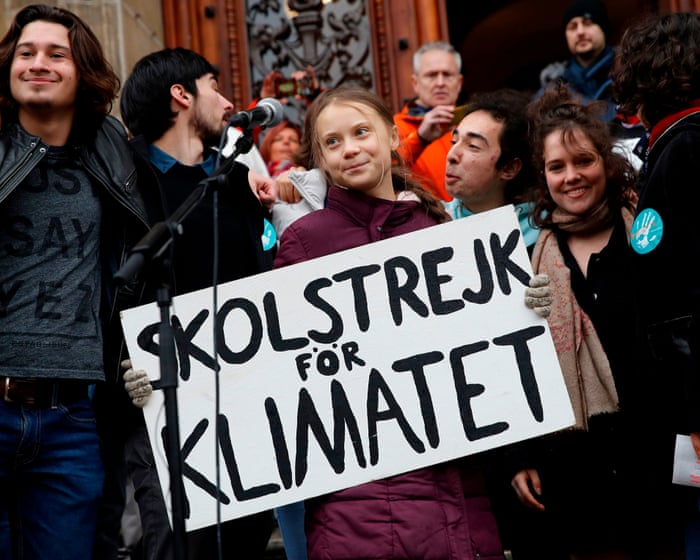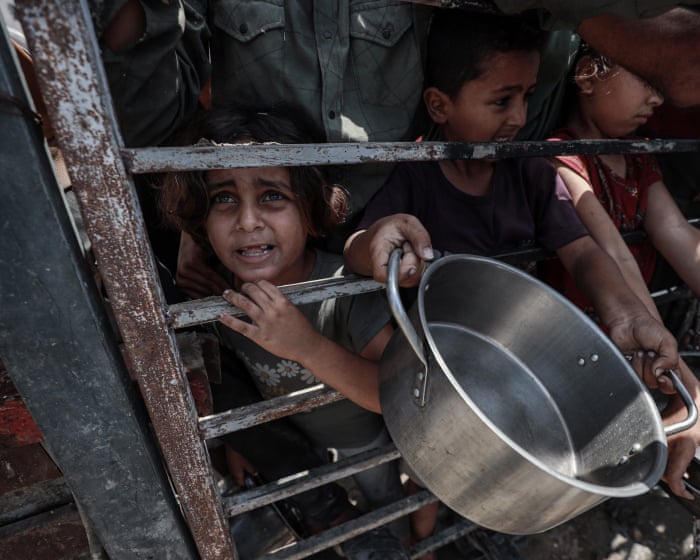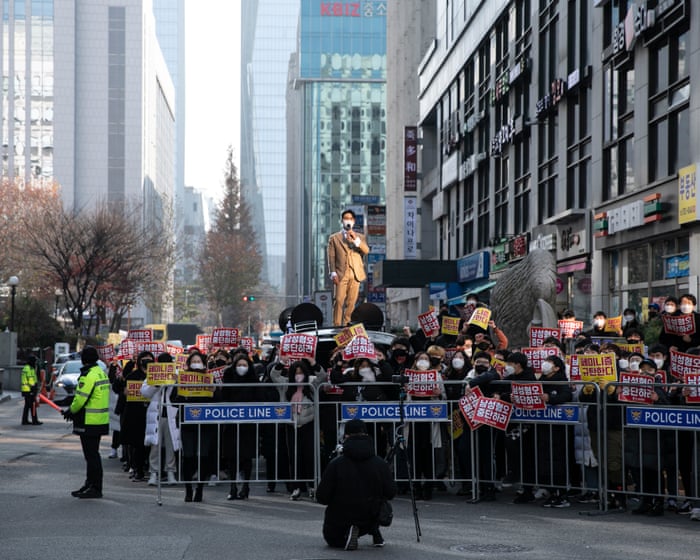In August 2018, Greta Thunberg sat alone on the ground outside the Swedish parliament, holding a sign that read “Skolstrejk för klimatet” (School strike for climate), with a stack of pamphlets weighed down by a stone. An older woman approached and asked, “Why are you on strike? You should be in school.” Greta replied, “Why should I get an education if there’s no future?”
“If you get an education, you can shape the future,” the woman responded. “That’s what you young people are meant to do. For us older ones, it’s too late.”
“It’s not too late,” Greta insisted. After a brief exchange, the woman walked away, looking troubled.
Soon, a younger woman stopped and asked, “Hi, can I sit with you?” Greta said yes. “I just wanted to say what you’re doing is really cool,” the woman told her. “Do many people stop by?” Greta replied, “So far today, three.” They sat together. Then a young man, still wearing his bike helmet, paused to ask, “How long have you been here?”
Gradually, more people began to stop, read the pamphlets, and join her. This scene opens Nathan Grossman’s documentary, I Am Greta. Within seven months, a million people had joined the Fridays for Future school strike movement.
The way such movements begin follows a common pattern. In a well-known TED Talk, Derek Sivers describes a video showing a lone, shirtless man dancing wildly on a grassy slope at what appears to be a festival. Others sit nearby, likely thinking, “Who is that crazy guy?”
Then something shifts: a second person stands up and starts dancing along, copying the moves. The first dancer immediately welcomes him as an equal, taking his hands, and they dance together. Now it’s about both of them, not just one. As Sivers puts it, “the first follower is what transforms a lone nut into a leader.” That first follower shows everyone else how to join in, calling and gesturing to friends. A second follower joins, then a third—suddenly, it’s a crowd, and they draw attention. More people join, and the movement snowballs.
Sivers calls this “the tipping point.” Once enough people are involved, it becomes less risky for others to participate—they won’t stand out or face ridicule. Soon, even reluctant individuals feel compelled to join, wanting to be part of the group and the new norm.
This is how social movements reach a tipping point. Both Greta and the lone dancer challenged social norms—skipping school to protest, or making a spectacle in public. Greta was also challenging norms of inaction on climate change. There’s a social barrier to initiating change; it takes a particular kind of courage to be the first to go against the grain. That action must be public, and it may be met with resistance, ridicule, or indifference. Greta herself faced harsh criticism in some media. But by setting an example, the first person invites others to challenge the status quo.
The first follower creates a reinforcing cycle, making it easier for the next person to break from norms and join. Each new participant encourages another, creating a ripple effect. If this amplification is strong enough, it reaches a tipping point. At a critical mass, social incentives reverse, and change becomes self-sustaining.
At the beginning of a social movement, those who join change their actions, though not necessarily their views.People often already agree with the values behind a movement—they may enjoy dancing or believe climate change is a serious threat that requires urgent political action. But before seeing others join in, they may not have felt brave enough to break away from the status quo.
At a certain point, however, a movement can begin to sway those who were once indifferent or even opposed to its goals. Historic shifts like the abolition of the slave trade, women’s suffrage, marriage equality, and the legalization of abortion in Ireland all seemed impossible at first, but later came to be seen as inevitable.
Afterward, we sometimes hear people who once opposed these changes claim, “Of course, I’ve always supported the movement.” This is a very human response—we tend to align with the crowd, and as public opinion shifts, so do we.
Such change can go so far as to reshape our entire worldview and beliefs. This is encouraging, because to prevent climate tipping points, we need to transform society. For many, that will mean rethinking how we see the world.
Greta Thunberg, for example, experienced a profound shift in perspective as she learned more about climate change. As she explained, “One thing I found very scary is the idea of tipping points—once we cross them, there’s no going back. It sets off a chain reaction beyond our control.”
Her response was to focus on changing the future while it’s still possible, rather than just worrying about it. By starting a school strike, Greta sparked her own chain reaction. Along with her early supporters, she helped trigger a social tipping point that fueled growing climate protests. But Greta and the millions who have joined her are striving for an even larger transformation.
Her goal was to spur decisive political action on climate change, which would involve deep and varied shifts. Ultimately, it means moving societies from an unsustainable state to a sustainable one. A key part of this is transitioning from a fossil fuel-based economy to a decarbonized one.
Achieving this overarching change will require many smaller tipping points: shifts in social norms, transformations in personal worldviews, advances in technology adoption, and reforms in governance.
For now, let’s outline the broader picture. We can think of society as being in an unsustainable, fossil fuel-driven state—the status quo—with a sustainable alternative on the other side, separated by a barrier. This barrier exists for many reasons. We are, to varying degrees, locked into existing systems—our habits, technologies, infrastructures, and ways of thinking.
While most people simply go along with the status quo, and some, like Greta, actively challenge it, there are others working to maintain it. These are often those who benefit most from things staying as they are, or who feel most threatened by change. These incumbents reinforce feedback loops that preserve the current system.
For instance, the fossil fuel industry concealed its own climate research and spread doubt about the science. It has also actively lobbied governments to protect its interests.Thank you for your support. Governments offer subsidies and tax incentives for fossil fuel extraction and use, while banks finance these industries. In return, the fossil fuel sector pays banks through dividends and keeps governments in favor by maintaining voter satisfaction. This cycle helps preserve the current, unsustainable system.
To shift away from this status quo, we need a social tipping point—a fundamental change driven by people and their choices, which either uphold or challenge the existing order.
For those committed to change, there are two complementary approaches: weakening the feedback loops that sustain the current system, or strengthening those that accelerate progress.
Social movements—such as the suffragettes or climate activists—have historically been powerful catalysts for change. They amplify their impact by increasing political pressure through escalating protests, targeting and challenging those in power to disrupt the mechanisms that preserve the status quo. Campaigns like fossil fuel divestment are examples of this strategy.
At the same time, everyone can help strengthen positive feedback loops. Adopting lower-emission technologies or behaviors—like eating less meat—can inspire others to follow suit through social influence. The more people who make these changes, the greater the ripple effect.
Technologies also benefit from increasing returns: as more people adopt innovations like solar panels, wind turbines, or electric vehicles, they become better, cheaper, and more widely available due to learning-by-doing and economies of scale. This, in turn, spurs further advancements and accessibility.
Positive Tipping Points: How to Fix the Climate Crisis is published by Oxford University Press.
Frequently Asked Questions
Of course Here is a list of FAQs about the growth of Greta Thunbergs movement framed around the idea that as more people join the risk decreases
General Beginner Questions
1 What does as more people join the risk decreases mean in this context
It means that when one person protests alone they can be easily ignored or face backlash But when thousands or millions of people join the message becomes too powerful to ignore and the risk of any single person being targeted or dismissed is dramatically reduced
2 How did Greta Thunbergs protest start
It began in August 2018 when 15yearold Greta started skipping school every Friday to sit alone outside the Swedish parliament with a sign that read Skolstrejk fr klimatet
3 Why did her solo protest resonate with so many people
Her message was simple urgent and scientifically backed Her genuine passion and frustration cut through the noise and her youth made the stakes feel incredibly personal for the future generation
4 What is the movement called
Its most widely known as Fridays for Future
Advanced Detailed Questions
5 What was the key turning point that made it go global
Her speech at the UN Climate Change Conference in December 2018 went viral This gave her a massive international platform inspiring students worldwide to organize their own strikes
6 How did social media contribute to the movements growth
Social media especially Twitter and Instagram allowed her story and the FridaysForFuture hashtag to spread organically and rapidly It enabled local organizers in different countries to connect share resources and coordinate global strike dates
7 Did the movement face any criticism or problems
Yes Common criticisms included concerns about students missing school claims that they were being manipulated by adults and personal attacks on Greta herself The decentralized nature of the movement also sometimes led to mixed messaging
8 What is an example of the risk decreasing with more people
Initially Greta was a lone teenager who could have been dismissed as a truant As millions joined critics could no longer focus on her as an individual The conversation shifted from who is this girl to what are we going to do about the climate crisis
Practical




